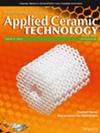Brazing mechanism and shear strength of SiAlON/WC‐Co joint using Ag–Cu–Ti active filler
IF 1.8
4区 材料科学
Q2 MATERIALS SCIENCE, CERAMICS
引用次数: 0
Abstract
This work investigated the formation mechanism and the effects of temperature on the microstructure and shear strength of vacuum‐brazed SiAlON ceramic/WC‐Co cemented carbide joints using an Ag–Cu–Ti active filler as the interlayer. The diffusion of Ti elements toward substrates and their subsequent reaction during the brazing process led to the formation of TiN, TiC, and Ti使用银铜钛活性填料的 SiAlON/WC-Co 接头的钎焊机理和剪切强度
这项研究探讨了以 Ag-Cu-Ti 活性填料为中间层的真空钎焊 SiAlON 陶瓷/WC-Co 硬质合金接头的形成机理以及温度对其微观结构和剪切强度的影响。在钎焊过程中,Ti 元素向基底的扩散及其随后的反应导致了 TiN、TiC 和 Ti5Si3 相的形成,并在这些相中形成了特征反应层。在 SiAlON 基材一侧形成了连续的 TiN 反应层,在 WC 基材一侧形成了 TiC 反应层。陶瓷相(Ti5Si3 TiN 和 TiC)分布在钎焊中间层中。在 850°C 时,钎焊接头的最高剪切强度为 325.28 ± 20.27 兆帕,这证明了 Ag-Cu-Ti 活性填料在生产坚固接头方面的可行性。
本文章由计算机程序翻译,如有差异,请以英文原文为准。
求助全文
约1分钟内获得全文
求助全文
来源期刊

International Journal of Applied Ceramic Technology
工程技术-材料科学:硅酸盐
CiteScore
3.90
自引率
9.50%
发文量
280
审稿时长
4.5 months
期刊介绍:
The International Journal of Applied Ceramic Technology publishes cutting edge applied research and development work focused on commercialization of engineered ceramics, products and processes. The publication also explores the barriers to commercialization, design and testing, environmental health issues, international standardization activities, databases, and cost models. Designed to get high quality information to end-users quickly, the peer process is led by an editorial board of experts from industry, government, and universities. Each issue focuses on a high-interest, high-impact topic plus includes a range of papers detailing applications of ceramics. Papers on all aspects of applied ceramics are welcome including those in the following areas:
Nanotechnology applications;
Ceramic Armor;
Ceramic and Technology for Energy Applications (e.g., Fuel Cells, Batteries, Solar, Thermoelectric, and HT Superconductors);
Ceramic Matrix Composites;
Functional Materials;
Thermal and Environmental Barrier Coatings;
Bioceramic Applications;
Green Manufacturing;
Ceramic Processing;
Glass Technology;
Fiber optics;
Ceramics in Environmental Applications;
Ceramics in Electronic, Photonic and Magnetic Applications;
 求助内容:
求助内容: 应助结果提醒方式:
应助结果提醒方式:


